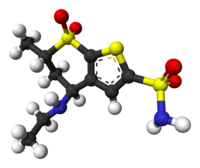Dorzolamide
 | |
 | |
| Clinical data | |
|---|---|
| Trade names | Trusopt, others |
| AHFS/Drugs.com | Monograph |
| MedlinePlus | a602022 |
| Routes of administration | Topical (eye drops) |
| ATC code | |
| Legal status | |
| Legal status |
|
| Pharmacokinetic data | |
| Protein binding | ~33% |
| Elimination half-life | 4 months |
| Identifiers | |
| |
| CAS Number |
|
| PubChem CID | |
| IUPHAR/BPS | |
| DrugBank | |
| ChemSpider | |
| UNII |
|
| KEGG | |
| ChEBI | |
| ChEMBL | |
| CompTox Dashboard (EPA) | |
| Chemical and physical data | |
| Formula | C10H16N2O4S3 |
| Molar mass | 324.43 g·mol−1 |
| 3D model (JSmol) | |
| |
| |
| | |
Dorzolamide, sold under the brand name Trusopt among others, is a medication used to treat high pressure inside the eye including glaucoma.[1] It is used as an eye drop.[1] Effects begin within three hours and lasts for at least eight hours.[1] It is also available as the combination dorzolamide/timolol.[1]
Common side effects include eye discomfort, eye redness, taste changes, and blurry vision.[1] Serious side effects include Steven Johnson syndrome.[1] Those allergic to sulfonamides may be allergic to dorzolamide.[1][2] Use is not recommended in pregnancy or breastfeeding.[2] It is a carbonic anhydrase inhibitor and works by decreasing the production of aqueous humour.[1]
Dorzolamide was approved for medical use in the United States in 1994.[1] It is available as a generic medication.[2] In 2017, it was the 281st most commonly prescribed medication in the United States, with more than one million prescriptions.[3][4] It is a second-generation carbonic anhydrase inhibitor.
Medical uses[]
Dorzolamide hydrochloride is used to lower excessive intraocular pressure in open-angle glaucoma and ocular hypertension. This drug is able to cross the cornea, reach the ciliary body of the eye, and produce systemic effects on the carbonic anhydrase enzyme within the eye.
Side effects[]
Ocular stinging, burning, itching and bitter taste.[5] It causes shallowing of the anterior chamber and leads to transient myopia. As a second generation carbonic anhydrase inhibitor, Dorzolamide avoids systemic effects associated with first generation carbonic anhydrase inhibitors such as Acetazolamide, Methazolamide, and Dichlorphenamide.
Pharmacodynamics[]
This section needs expansion. You can help by . (January 2019) |
It lowers IOP by about 20%.[5] Carbonic Anhydrase can convert H2CO3 into HCO3 (bicarbonate) and H+. The H+ is then exchanged for sodium (Na) which allows you to make aqueous humor. By blocking carbonic anhydrase, the Na/H exchanger can't work, which will decrease Na in the cell and prevent aqueous humor production.
History[]
This drug, developed by Merck, was the first drug in human therapy (market introduction 1995) that resulted from structure-based drug design. It was developed to circumvent the systemic side effects of acetazolamide which has to be taken orally.[5]
References[]
- ^ a b c d e f g h i "Dorzolamide Hydrochloride Monograph for Professionals". Drugs.com. American Society of Health-System Pharmacists. Retrieved 26 March 2019.
- ^ a b c British national formulary : BNF 76 (76 ed.). Pharmaceutical Press. 2018. p. 1148. ISBN 9780857113382.
- ^ "The Top 300 of 2020". ClinCalc. Retrieved 11 April 2020.
- ^ "Dorzolamide Hydrochloride - Drug Usage Statistics". ClinCalc. Retrieved 11 April 2020.
- ^ a b c KD Tripari MD (2004). Essentials of Medical Pharmacology (5th ed.). Jaypee Brothers Medical Publishers(P) Ltd. p. 88. ISBN 81-8061-187-6.
Further reading[]
- Kubinyi H (1999). "Chance favors the prepared mind--from serendipity to rational drug design". J Recept Signal Transduct Res. 19 (1–4): 15–39. doi:10.3109/10799899909036635. PMID 10071748.
- Plummer C, MacKay E, Gelatt K (2006). "Comparison of the effects of topical administration of a fixed combination of dorzolamide-timolol to monotherapy with timolol or dorzolamide on IOP, pupil size, and heart rate in glaucomatous dogs". Veterinary Ophthalmology. 9 (4): 245–9. doi:10.1111/j.1463-5224.2006.00469.x. PMID 16771760.
- Grover S, Apushkin M, Fishman G (2006). "Topical dorzolamide for the treatment of cystoid macular edema in patients with retinitis pigmentosa". Am J Ophthalmol. 141 (5): 850–8. doi:10.1016/j.ajo.2005.12.030. PMID 16546110.
- Almeida G, Faria e Souza S (2006). "Effect of topical dorzolamide on rabbit central corneal thickness". Braz J Med Biol Res. 39 (2): 277–81. doi:10.1590/S0100-879X2006000200015. PMID 16470316.
- Carbonic anhydrase inhibitors
- Sulfones
- Sulfonamides
- Merck & Co. brands
- Amines